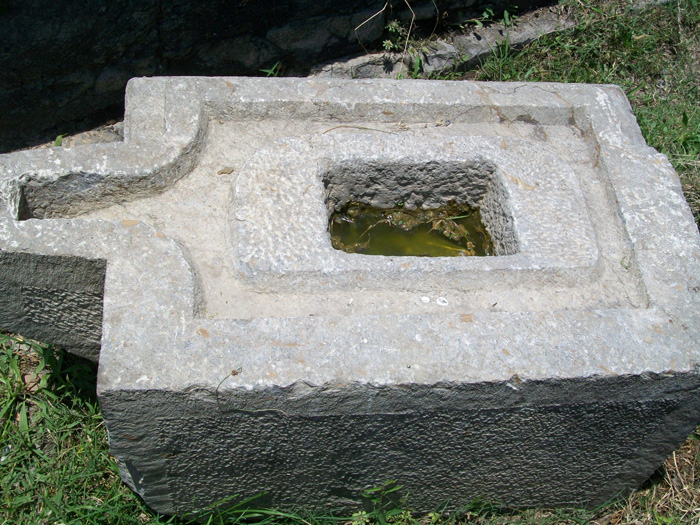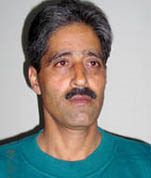| | |
|
Forgotten Temples of
Photo series Part-12 An effort to preserve and record Hindu cultural and religios heritage of Kashmir AVANTISVAMIN TEMPLE AT AWANTIPORA 
Exclusive images and report from a remote village in Kashmir provided for Shehjarby Chander M. Bhat | |
|
Awantipora
(Vuumtopur in Kashmiri) is a place, about 30 km from Srinagar on
Srinagar-Jammu National Highway. The place is famous not only as a
ancient capital city of Avantipora founded by Rajaj Avantivarman, but
also for its two imposing temples, now in ruins, built by him. The ruins
of temples constructed by Lalitaditya, the Brahmin emperor of Kashmir,
and King Awantivarman are located in Awantipora. The temples are located
at 33°55′24″N 75°00′46″E 33.9232602°N 75.012846°E33.9232602; 75.012846
and 33°55′41″N 75°00′16″E33.9279606°N 75.0045311°E 33.9279606;
75.0045311.
This is an historic temple built by Awanti Warman from whom the place got its name as Awantipora. The place is usually misrecognized by the people saying Pandavas place because the material used in building this place is usually panadava stones. That's why people misrecognize it. But all its history is written inside it. It is said that this temple has gone almost 20 feet deep under the earth and that only its top side is visible. One of these temples, Avantisvamin, a small one, was dedicated to Lord Vishnu, before Avantivarman’s accession to the throne and the second one, Avantesvara, a larger one, to Lord Shiva, after his accession to the throne. The original grandeur of these great temples has been lost and all that remains now are the architectural fragments strewn at their places of origin on the left side of Srinagar-Jammu road. Avantisvamin comes just before Awantipora on the bank of Vitasta and Avantesvara a few hundred metres away at village Jaubror, in Avantipora proper. Another ancient temple built by Avantisvamin was Sheer Mutt, located 6 km from Awantipora. Avantisvamin, one of the better preserved temples of the two, has an edifice, which comprised a colonnaded per style enclosing a paved courtyard 174 feet by 148 feet, in the centre of which is the main shrine, built on a double base with four small shrines at four corners. The centre shrine is built on double bases, the only decoration of which is a torus molding a cyma recta cornice. The base is intact, but the sanctum, 33 feet square externally, has almost disappeared. Avantesvara is situated in courtyard columns, but without any recesses behind. The gateway is in the middle of the wall and is divided into two chambers by a cross wall. The base on which the shrine in the centre of the courtyard stands is 57 feet and 10 feet high with stairs, 28 feet wide, on all the four sides, supported on either side by flank wall, 17 feet in length. The remains of these two temples represent finest examples of architecture of the times. One can see the gateways, standing in both the temples, the colonnade of the smaller temple and the semi-attached pillars of the arched recesses with elaborate carvings. Sikander Butshikan destroyed these magnificent temples. According to Lawrence, the complete ruin of Avantipora temples could have been affected by use of gunpowder by bigoted Sikander, whose idol breaking zeal procured him the tile of But-Shikan or “Iconoclast”. Notes and References 1. Place Names in Kashmir by B.K.raina and S.L.Sadhu, pulbished by Bharatiya Vidya Bhavan, Mumbai and Indira Gandhi National Centre for the Arts, New Delhio, 2000 2. Encyclopedia: Kashmiri Pandit: Culture and Heritage by C.L.Kaul published by Ansh Publication, 2009 | |

Base of another temple in the compound. These are the ruins of glorious past | |

Images of faith now as last testament | |

Base of the main temple. Brick by brick we can reconsturct ourselves again | |

Base of main temple. Peace behind the walls | |

Dying images on the wallts still exists but non-recognisible | |

Images of faith that never fades | |

aCorner of the main temple. Big boulders can also be shaped like this | |

Close view of the main entrance. Guideline to hinue masonary | |

IOnce the Lord of the Universe was resting on it | |

Window of the main temple. Path towards age old faith | |
| | |
 *Born on 20th March, 1960 in Murran a village in North Kashmir,
Chander M. Bhat is presently working as an Assistant Supdt. Posts, in
Department of Posts, Govt. of India. His articles regarding Posts and of
non-political nature stand widely published in various papers and
magazines of the country. A booklet 'How to Collect Stamps" published by
the Department of Posts, has earned him genuine accolades. He worked on
the project of tracing the roots of his co-villagers and of the village
Murran, resulting into the culmination of a widely acclaimed book
"Murran -My Village". Man with depth, Chander M. Bhat has also another
book, "Ocean by Drops" (collection of poems) in his vase having colorful
poems. His book "Ancient History of Jammu and Kashmir", confirms his
researching capability. Various research papers like "The Splendor that
is Amarnath" and "Vitasta" The Sacred River of Kashmir" are valuable
additions to his works that has proved very fruitful and guiding force
in the exile period of Kashmiri Pandits community of which the author is
also a member.
*Born on 20th March, 1960 in Murran a village in North Kashmir,
Chander M. Bhat is presently working as an Assistant Supdt. Posts, in
Department of Posts, Govt. of India. His articles regarding Posts and of
non-political nature stand widely published in various papers and
magazines of the country. A booklet 'How to Collect Stamps" published by
the Department of Posts, has earned him genuine accolades. He worked on
the project of tracing the roots of his co-villagers and of the village
Murran, resulting into the culmination of a widely acclaimed book
"Murran -My Village". Man with depth, Chander M. Bhat has also another
book, "Ocean by Drops" (collection of poems) in his vase having colorful
poems. His book "Ancient History of Jammu and Kashmir", confirms his
researching capability. Various research papers like "The Splendor that
is Amarnath" and "Vitasta" The Sacred River of Kashmir" are valuable
additions to his works that has proved very fruitful and guiding force
in the exile period of Kashmiri Pandits community of which the author is
also a member.Presently the author is working on "OOL - THE NEST" a six volume project on all the 595 (each volume of about 2500 pages)Kashmiri Pandit villages of Kashmir. Posted by Vipul Koul |
Tuesday, February 12, 2019
Forgotten Temples of Kashmir
Subscribe to:
Post Comments (Atom)
No comments:
Post a Comment